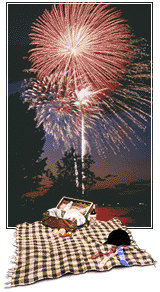History of July 4 Celebrations

America's biggest secular holiday
 John Adams wrote that the Fourth of July "...ought to be celebrated by pomp and parade, with shows, games, sports, guns, bells, bonfires, and illuminations from one end of this continent to the other..." RELATED LINKS |
America celebrates July 4 as Independence Day because it was on July 4, 1776, that members of the Second Continental Congress, meeting in Philadelphia, adopted the final draft of the Declaration of Independence.
Spontaneous Celebrations
Following its adoption, the Declaration was read to the public in various American cities. Whenever they heard it, patriots erupted in cheers and celebrations.
In 1777, Philadelphians remembered the 4th of July. Bells were rung, guns fired, candles lighted, and firecrackers set off. However, while the War of Independence dragged on, July 4 celebrations were modest at best.
When the war ended in 1783, July 4 became a holiday in some places. In Boston, it replaced the date of the Boston Massacre, March 5, as the major patriotic holiday. Speeches, military events, parades, and fireworks marked the day. In 1941, Congress declared July 4 a federal holiday.
Picnics and Games
Over time, various other summertime activities also came to be associated with the Fourth of July, including historical pageants, picnics, baseball games, watermelon-eating contests, and trips to the beach. Common foods include hot dogs, hamburgers, corn on the cob, apple pie, cole slaw, and sometimes clam bakes.
Colonial Attractions
While the Fourth is celebrated across the country, historic cities like Boston and Philadelphia draw huge crowds to their festivities.
In Boston, the USS John F. Kennedy often sails into the harbor, while the Boston Pops Orchestra holds a televised concert on the banks of the Charles River, featuring American music and ending with the 1812 Overture.
Philadelphia holds its celebrations at Independence Hall, where historic scenes are reenacted and the Declaration of Independence is read.
Rodeos and Candles
Other interesting parties include the American Indian rodeo and three-day pow-wow in Flagstaff, Arizona, and the Lititz, Pennsylvania, candle festival, where hundred of candles are floated in water and a "Queen of Candles" is chosen.
John Adams Urged Recognition
The second president, John Adams, would have approved. "I believe that it will be celebrated by succeeding generations as the great anniversary festival," he wrote his wife, Abigail. "It ought to be celebrated by pomp and parade, with shows, games, sports, guns, bells, bonfires, and illuminations from one end of this continent to the other..."
John Hancock Was First
John Hancock, the president of the Second Continental Congress, was the first to sign the Declaration. With its ornate capitals, Hancock's sprawling signature is prominent on the document. Since then, when people are asked for their "John Hancock," they are being asked to sign their names.
All 56 men who ultimately signed the Declaration showed great courage. Announcing independence from Great Britain was an act of treason, punishable by death.
A Marvelous Document
The Declaration of Independence itself has become one of the most admired and copied political documents of all time. It was written by Thomas Jefferson and revised by John Adams, Benjamin Franklin, and Jefferson.
The Declaration of Independence is a justification of the American Revolution, citing grievances against King George III. It is also a landmark philosophical statement, drawing on the writings of philosophers John Locke and Jean Jacques Rousseau. It affirms that since all people are creatures of God, or nature, they have certain natural rights, or liberties, that cannot be violated.
The Declaration and the American Revolution have since inspired freedom-seekers the around the world.
More Independence Day features!








